人教课标版高中英语选修8 Unit5 Meeting your ancestors Reading (共17张PPT)
文档属性
| 名称 | 人教课标版高中英语选修8 Unit5 Meeting your ancestors Reading (共17张PPT) | 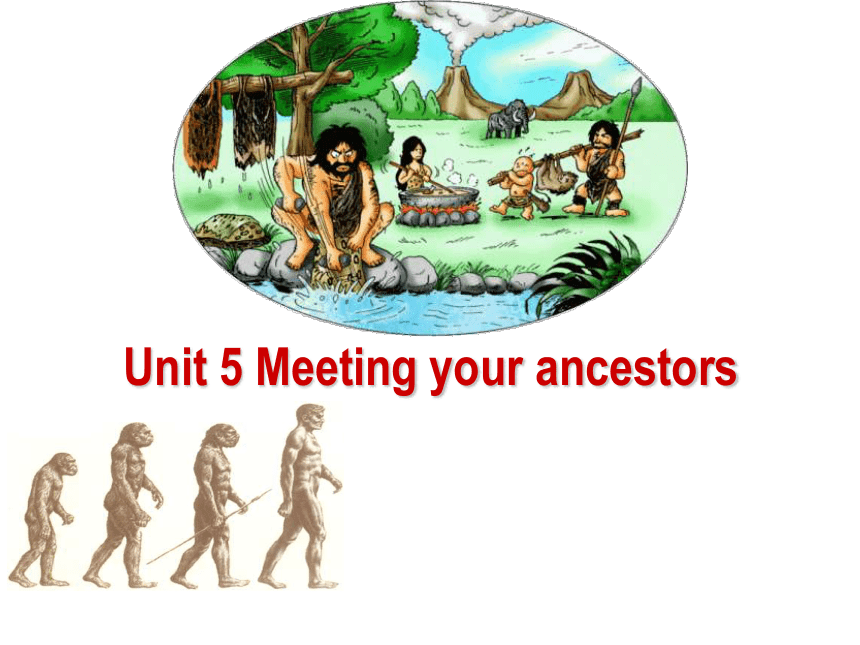 | |
| 格式 | zip | ||
| 文件大小 | 1.4MB | ||
| 资源类型 | 教案 | ||
| 版本资源 | 人教版(新课程标准) | ||
| 科目 | 英语 | ||
| 更新时间 | 2020-06-25 15:50:39 | ||
图片预览

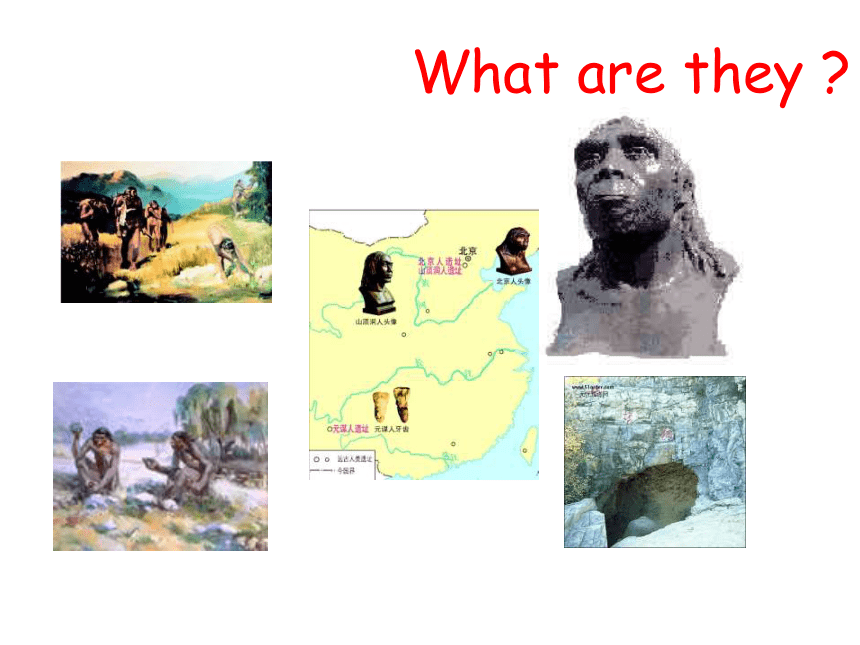
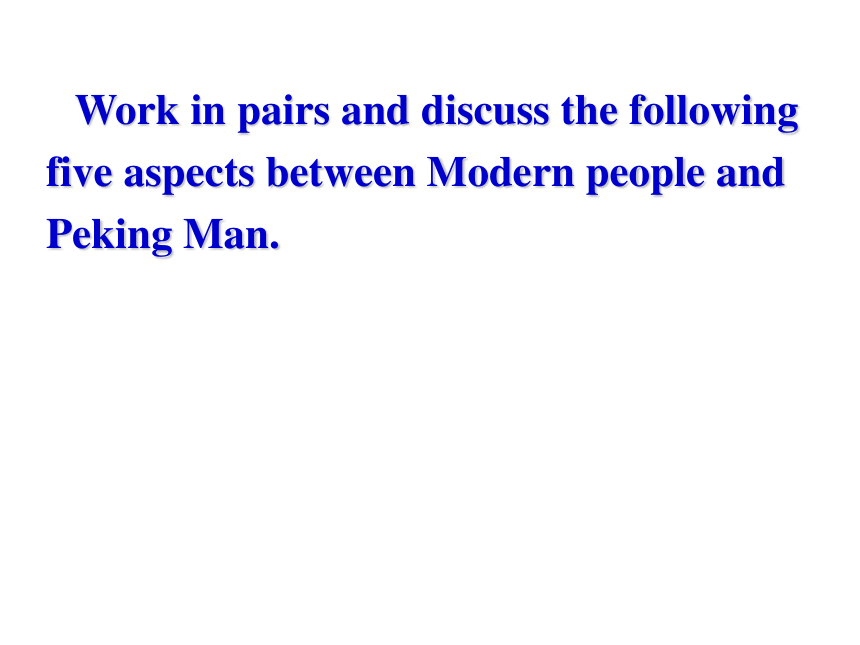
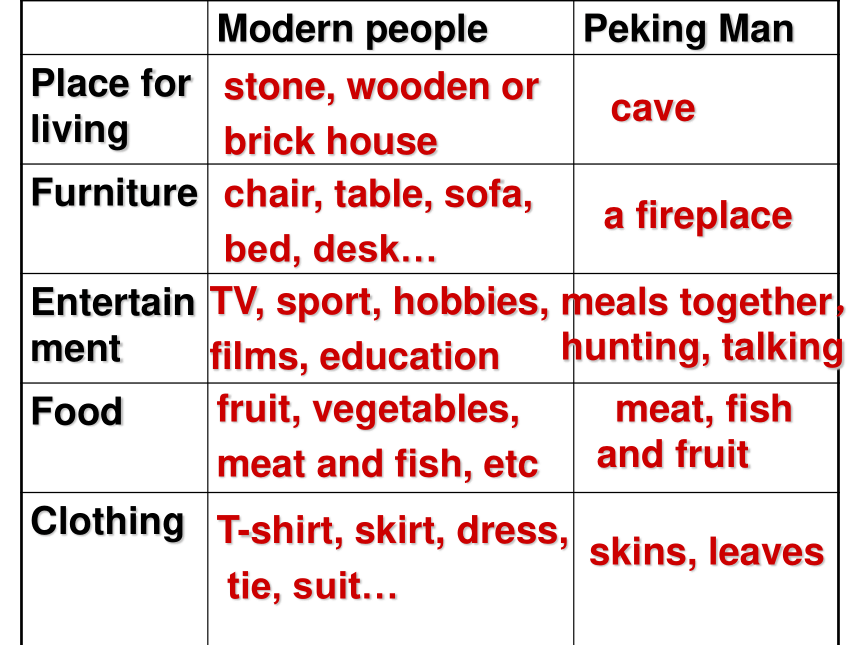
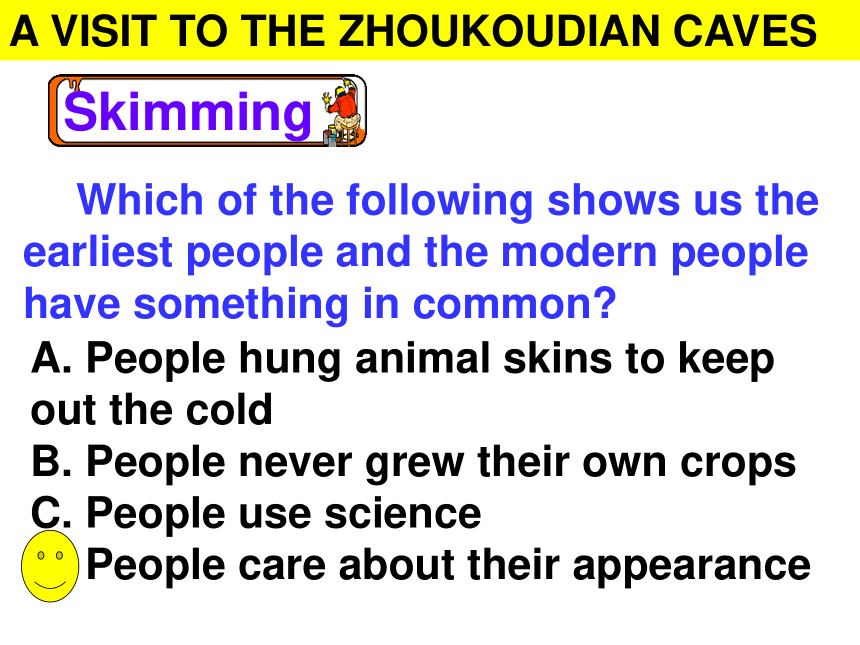
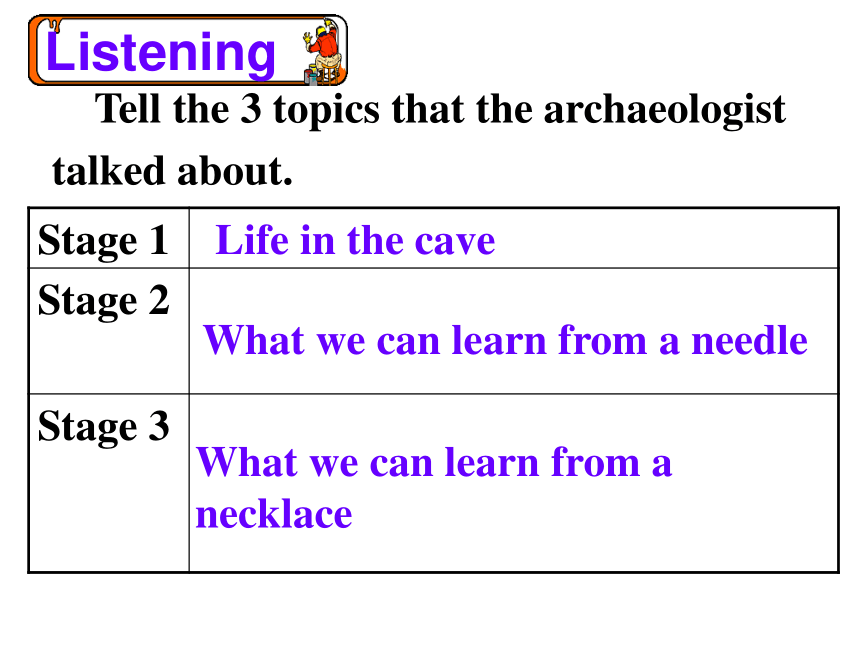
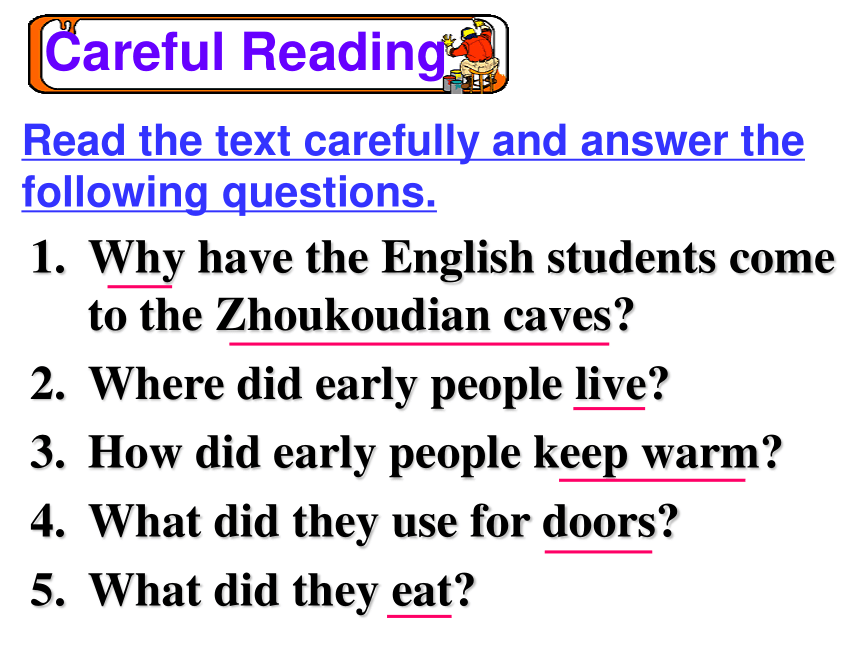
文档简介
(共17张PPT)
Unit
5
Meeting
your
ancestors
What
are
they
?
Work
in
pairs
and
discuss
the
following
five
aspects
between
Modern
people
and
Peking
Man.
stone,
wooden
or
brick
house
chair,
table,
sofa,
bed,
desk…
TV,
sport,
hobbies,
films,
education
fruit,
vegetables,
meat
and
fish,
etc
T-shirt,
skirt,
dress,
tie,
suit…
cave
a
fireplace
meals
together,
hunting,
talking
meat,
fish
and
fruit
skins,
leaves
Modern
people
Peking
Man
Place
for
living
Furniture
Entertainment
Food
Clothing
Which
of
the
following
shows
us
the
earliest
people
and
the
modern
people
have
something
in
common?
A
VISIT
TO
THE
ZHOUKOUDIAN
CAVES
A.
People
hung
animal
skins
to
keep
out
the
cold
B.
People
never
grew
their
own
crops
C.
People
use
science
D.
People
care
about
their
appearance
Skimming
Tell
the
3
topics
that
the
archaeologist
talked
about.
Listening
Life
in
the
cave
What
we
can
learn
from
a
needle
What
we
can
learn
from
a
necklace
Stage
1
Stage
2
Stage
3
Why
have
the
English
students
come
to
the
Zhoukoudian
caves?
Where
did
early
people
live?
How
did
early
people
keep
warm?
What
did
they
use
for
doors?
What
did
they
eat?
Read
the
text
carefully
and
answer
the
following
questions.
Careful
Reading
Why
have
the
English
students
come
to
the
Zhoukoudian
caves?
Where
did
early
people
live?
The
students
want
to
find
out
about
how
early
people
lived.
There
are
no
such
sites
in
England
while
the
Zhoukoudian
caves
provide
an
excellent
example
of
a
site
where
early
people
lived.
Early
people
lived
in
caves.
How
did
early
people
keep
warm?
What
did
they
use
for
doors?
What
did
they
eat?
They
used
fur
from
animals
for
clothes
and
had
fires
burning
all
winter.
The
archaeologist
thinks
they
may
have
used
animal
skins.
They
ate
animal
meat,
such
as
tigers
and
bears,
and
fish
from
the
lake
nearby.
They
also
picked
fruit
when
it
was
ripe.
scare
burning
Careful
reading
I.
Read
the
text
carefully
and
fill
in
the
blanks.
Relics
Descriptions
of
the
relics
Conclusions
Caves
Human
and
animal
bones,
tools
and
ornaments
in
those
caves.
Early
people
lived
in
the
caves.
They
used
fire
to
keep
warm,
cook
food
and
____
wild
animals
away.
They
might
have
kept
the
fire
_______
all
winter
Layers
skins
Relics
Descriptions
of
the
relics
Conclusions
Caves
Fireplaces
in
the
centre
of
the
caves
______
of
ash
almost
six
metres
thick
No
doors
They
might
have
hung
animal
____
at
the
cave
mouth
to
keep
out
the
cold.
Tigers
and
bears
might
have
been
their
most
dangerous
enemies.
bone
clothes
trade
seaside
Relics
Descriptions
of
the
relics
Conclusions
A
needle
At
most
three
centimetres
long
Made
of
____.
Perhaps
they
cut
animal
skins
and
sewed
the
pieces
together
to
make
______.
A
necklace
Made
of
animal
bones
and
shells
There
was
_____
between
them
or
they
travelled
to
the
______
on
their
journeys.
Read
the
text
carefully
and
choose
the
best
answer.
1.
Where
do
the
caves
lie?
A.
In
the
forest.
B.
On
the
seaside.
C.
At
the
foot
of
the
hill.
D.
Higher
up
the
hill.
2.
Which
of
the
following
is
the
correct
order
about
how
early
people
made
clothes?
a.
clean
the
fat
and
meat
from
the
skin
b.
cut
up
the
animals
c.
rub
salt
inside
the
skin
d.
remove
the
skin
e.
sew
the
pieces
together
A.
b-d-c-a-e
B.
b-d-a-c-e
C.
b-a-d-c-e
D.
b-a-c-d-e
3.
Which
of
the
following
shows
us
the
earliest
people
and
the
modern
people
have
something
in
common?
A.
People
hung
animal
skins
to
keep
out
the
cold
B.
People
never
grew
their
own
crops
C.
People
use
science
D.
People
care
about
their
appearance
4.
What
can
we
infer
from
the
sentences---
“This
one
looks
very
like
a
fish
bone.
Is
it
reasonable?
---Yes
indeed,
as
the
botanical
analyses
have
shown
us,
all
the
fields
around
here
used
to
be
part
of
a
large
shallow
lake.
Probably
there
were
fish
in
it.”?
A.
Being
an
archaeologist
needs
a
wide
range
of
knowledge.
B.
A
lake
is
not
the
sea.
C.
People
can
identify
the
fish
by
the
colour.
D.
A
fish
bone
can
be
made
into
a
necklace.
写作训练:请你用5句话介绍北京猿人。
[写作内容]
1.北京人生活在70万年--20万年前,
而北京猿人的化石首次发现于1927年。
2.北京猿人能够制造和使用劳动工具,
3.能用天然火取暖、熟食和吓退野兽
。
4.生活艰苦,寿命比较短暂。
5.他们群居在洞穴中,以狩猎为生。
[写作要求]
1.只能使用5个句子表达全部内容;
2.介绍必须包括所有要点。
Homework
Unit
5
Meeting
your
ancestors
What
are
they
?
Work
in
pairs
and
discuss
the
following
five
aspects
between
Modern
people
and
Peking
Man.
stone,
wooden
or
brick
house
chair,
table,
sofa,
bed,
desk…
TV,
sport,
hobbies,
films,
education
fruit,
vegetables,
meat
and
fish,
etc
T-shirt,
skirt,
dress,
tie,
suit…
cave
a
fireplace
meals
together,
hunting,
talking
meat,
fish
and
fruit
skins,
leaves
Modern
people
Peking
Man
Place
for
living
Furniture
Entertainment
Food
Clothing
Which
of
the
following
shows
us
the
earliest
people
and
the
modern
people
have
something
in
common?
A
VISIT
TO
THE
ZHOUKOUDIAN
CAVES
A.
People
hung
animal
skins
to
keep
out
the
cold
B.
People
never
grew
their
own
crops
C.
People
use
science
D.
People
care
about
their
appearance
Skimming
Tell
the
3
topics
that
the
archaeologist
talked
about.
Listening
Life
in
the
cave
What
we
can
learn
from
a
needle
What
we
can
learn
from
a
necklace
Stage
1
Stage
2
Stage
3
Why
have
the
English
students
come
to
the
Zhoukoudian
caves?
Where
did
early
people
live?
How
did
early
people
keep
warm?
What
did
they
use
for
doors?
What
did
they
eat?
Read
the
text
carefully
and
answer
the
following
questions.
Careful
Reading
Why
have
the
English
students
come
to
the
Zhoukoudian
caves?
Where
did
early
people
live?
The
students
want
to
find
out
about
how
early
people
lived.
There
are
no
such
sites
in
England
while
the
Zhoukoudian
caves
provide
an
excellent
example
of
a
site
where
early
people
lived.
Early
people
lived
in
caves.
How
did
early
people
keep
warm?
What
did
they
use
for
doors?
What
did
they
eat?
They
used
fur
from
animals
for
clothes
and
had
fires
burning
all
winter.
The
archaeologist
thinks
they
may
have
used
animal
skins.
They
ate
animal
meat,
such
as
tigers
and
bears,
and
fish
from
the
lake
nearby.
They
also
picked
fruit
when
it
was
ripe.
scare
burning
Careful
reading
I.
Read
the
text
carefully
and
fill
in
the
blanks.
Relics
Descriptions
of
the
relics
Conclusions
Caves
Human
and
animal
bones,
tools
and
ornaments
in
those
caves.
Early
people
lived
in
the
caves.
They
used
fire
to
keep
warm,
cook
food
and
____
wild
animals
away.
They
might
have
kept
the
fire
_______
all
winter
Layers
skins
Relics
Descriptions
of
the
relics
Conclusions
Caves
Fireplaces
in
the
centre
of
the
caves
______
of
ash
almost
six
metres
thick
No
doors
They
might
have
hung
animal
____
at
the
cave
mouth
to
keep
out
the
cold.
Tigers
and
bears
might
have
been
their
most
dangerous
enemies.
bone
clothes
trade
seaside
Relics
Descriptions
of
the
relics
Conclusions
A
needle
At
most
three
centimetres
long
Made
of
____.
Perhaps
they
cut
animal
skins
and
sewed
the
pieces
together
to
make
______.
A
necklace
Made
of
animal
bones
and
shells
There
was
_____
between
them
or
they
travelled
to
the
______
on
their
journeys.
Read
the
text
carefully
and
choose
the
best
answer.
1.
Where
do
the
caves
lie?
A.
In
the
forest.
B.
On
the
seaside.
C.
At
the
foot
of
the
hill.
D.
Higher
up
the
hill.
2.
Which
of
the
following
is
the
correct
order
about
how
early
people
made
clothes?
a.
clean
the
fat
and
meat
from
the
skin
b.
cut
up
the
animals
c.
rub
salt
inside
the
skin
d.
remove
the
skin
e.
sew
the
pieces
together
A.
b-d-c-a-e
B.
b-d-a-c-e
C.
b-a-d-c-e
D.
b-a-c-d-e
3.
Which
of
the
following
shows
us
the
earliest
people
and
the
modern
people
have
something
in
common?
A.
People
hung
animal
skins
to
keep
out
the
cold
B.
People
never
grew
their
own
crops
C.
People
use
science
D.
People
care
about
their
appearance
4.
What
can
we
infer
from
the
sentences---
“This
one
looks
very
like
a
fish
bone.
Is
it
reasonable?
---Yes
indeed,
as
the
botanical
analyses
have
shown
us,
all
the
fields
around
here
used
to
be
part
of
a
large
shallow
lake.
Probably
there
were
fish
in
it.”?
A.
Being
an
archaeologist
needs
a
wide
range
of
knowledge.
B.
A
lake
is
not
the
sea.
C.
People
can
identify
the
fish
by
the
colour.
D.
A
fish
bone
can
be
made
into
a
necklace.
写作训练:请你用5句话介绍北京猿人。
[写作内容]
1.北京人生活在70万年--20万年前,
而北京猿人的化石首次发现于1927年。
2.北京猿人能够制造和使用劳动工具,
3.能用天然火取暖、熟食和吓退野兽
。
4.生活艰苦,寿命比较短暂。
5.他们群居在洞穴中,以狩猎为生。
[写作要求]
1.只能使用5个句子表达全部内容;
2.介绍必须包括所有要点。
Homework
